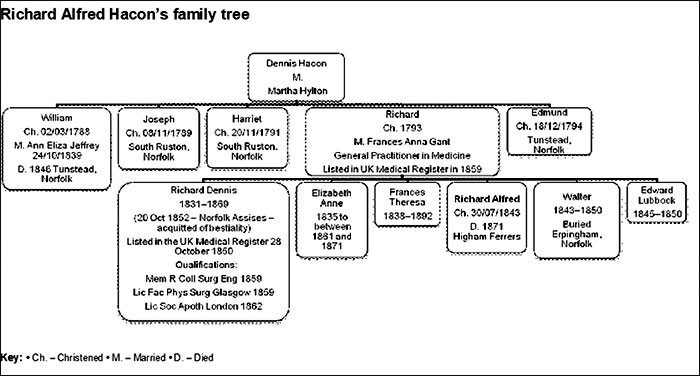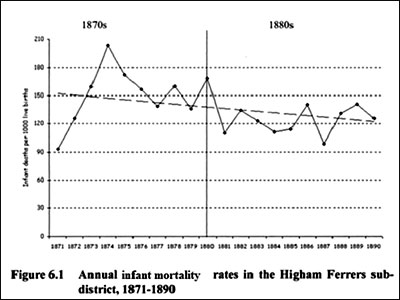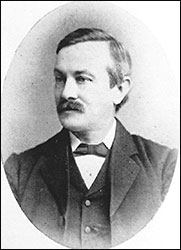|
|
Article by Brenda Lofthouse
|
|
Typhoid in the 19th Century
|
|
|
|
Foreword
In 2014 The Friends of St Mary’s was launched with the purpose of supporting the maintenance of the exterior of St Mary’s Church, Higham Ferrers. The trustees subsequently developed a number of projects such as improving the area to the north of the Church where a memorial to servicemen killed in World War 1 is displayed, and planting spring bulbs in the churchyard. In addition, two research projects have been carried out, one into the Jolley family whose grave is fenced with a small iron railing on to which are placed memorials to members of the family, and this second project, researching the life and times of Richard Alfred Hacon. Information about the Jolley family can be found at www.friendsstmaryshigham.org.uk. A leaflet can also be obtained from the Town Hall and Higham Ferrers Library. That publication was paid for by Councillor Anna Sauntson using her Community Empowerment Grant.
 |
|
|
This project focussing on Richard Alfred Hacon started with the cleaning of the memorial to him in the churchyard. I carried out the research for both projects but significant contributions to the Hacon project were made by others to enable this present work to be completed. First Pauline McDermott managed to get a copy of Dr Home’s report into the sanitary conditions in Higham Ferrers in 1871 through her contacts with The University of Toronto. Despite the information that the original report was lodged in the National Archives at Kew, it was never located, and without Pauline’s help the information within it would never have been found.
Secondly Eric Fowell has been and always is courteous, kind and exceptionally helpful. It is due to him that the work is completed with information about the building of The Higham Ferrers and Rushden Reservoir (now Sywell Country Park). Eric has a significant archive of material and has been very generous in sharing both the material and his expertise.
Father Richard and the Churchwardens of St Mary’s are thanked for providing a picture of Richard Hacon. It is exceptionally helpful to have a picture of the man at the heart of this story, a rare find.
While it is relatively easy to find the information, laying out the document in a manner that both enhances the text and shapes it to provide clarity, is a different matter. Many thanks are due to Pam Webbley whose expertise has been of great value, and who showed great patience in dealing with numerous requests and minor alterations.
Finally, thanks are due to the Trustees of The Friends of St Mary’s as a whole for the encouragement they have always shown towards this and the Jolley project.
Brenda Lofthouse, September 2016
|
|
|
Typhoid in Higham Ferrers in the 19th Century
|
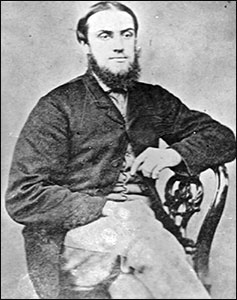 |
Richard Alfred Hacon 1842–1871
|
|
On the north side of St Mary’s Church there is an obelisk dedicated to the memory of Richard Alfred Hacon, Surgeon, who remained in Higham Ferrers during a particularly severe outbreak of typhoid fever in the town. The memorial records his “unwearying self denial” on behalf of the people in Higham, but he also caught the disease and died at the age of 29 in 1871.
The causes of the outbreak were disputed, but the lack of clean water, the absence of an effective sewage system, inadequate diet amongst a significant number of the population combined with poor housing conditions all made the outbreaks of the disease a probable occurrence.
Richard Alfred (also known as Alfred Richard) was born in Norfolk, the second son of Richard and Frances. His father was a medical practitioner and Richard followed suit. At some point in the mid-1860s he left Norfolk and became Assistant Surgeon in Higham Ferrers.
He came to a town that was gradually expanding in population but whose infrastructure had not changed over the centuries. In particular the supply of water to the town was limited, and this proved increasingly problematic.
|
The problems with the water supply
Water from wells was the only water supply to the town. There were five public wells and at least eighty-four private ones. Two separate sewers ran along the main street in Higham, one running north and one south, and the waste material carried by these sewers was emptied into open ditches at either end of the town.
A few householders had been allowed to connect their old brick drains to the public sewers, but most households relied on privies with pits; a few houses did not have any privy provision at all. There were continual issues about finding a water source to flush the sewers.
Concerns had been raised before the outbreak of typhoid fever in 1871 about the state of the sewers and the impact on public health. In December 1868 a meeting was held to consider:
|
“whether it would contribute to the health and convenience of the inhabitants that the long ditch sewer or drain of an offensive nature or likely to be offensive to health should be drained cleaned and covered or filled up or that one or more sewers drain or drains should be made or improved”.1 |
|
| A Higham Ferrers Sewerage Authority was set up and for the following two years sought to raise a loan from central government to improve the sewers. However, delays ensued because the Authority did not supply sufficient information to support the grant request. |
|
|
“for borrowing the sum of £700 I have to request you furnish me with a plan of the district showing the lines of the sewers, their gradients and dimensions, and the outfall of the drainage, and that you fill up the enclosed forms of Estimates and Rateable value and return them to the office” 2 |
|
| The Higham Ferrers Sewage Authority did investigate possible options for improving the removal of waste material but regularly decided either against complete proposals or only implemented part of them. |
|
|
“The report of Mr Sharman as to the supply of water with his plans and estimate having been submitted to the meeting. Resolved that it would be impracticable to carry out the plans suggested by Mr Sharman.”3 |
|
While the Authorities responsible for sewerage continued to consider the issues, infant mortality in the early 1870s continued to rise.4
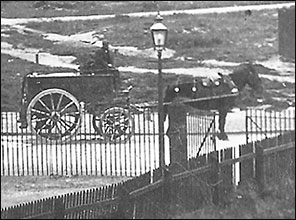 |
|
Water cart purchased by Rushden Urban District Council in 1908, similar to the one in use in Higham Ferrers in 1871. (Eric Fowell collection)
|
The weather in England in the winter of 1870 was very cold and the spring and summer of 1871 were very wet. The persistent bad weather caused considerable distress through the loss of the harvest and the difficulty in working the land. 5 The inclement weather did have an impact on food prices, but it did not reduce the smell from the sewers.The issue discussed by the Sewer Authority most frequently continued to be sourcing adequate water to flush the sewers, and to this end the Sewer Authority purchased a water cart. 6
Resolved that a water cart with its appendages by Coleman and Co at the cost price of £24 be ordered. [In actuality the Water Cart cost £21] By March 1871 Mr. Sharman was employed in cleaning the drains and had put in as costs £51.15s.0d.
However, this did not resolve any of the issues related to the emptying of sewage material into open ditches at the end of the town, or linking more properties to the main sewer.
Attempts to resolve the sewage problem
By May 1871 Dr. Thompson (Medical Officer for Higham Ferrers) wrote to Whitehall complaining of the poor state of affairs in Higham Ferrers.7
|
A system of drainage was planned for this place and carried out last summer and it was sanctioned by T Taylor on the part of the Secretary of State, only on condition that an adequate supply of water should be obtained for the purpose of flushing the sewers.
There has been no attempt made in the slightest degree to obtain an adequate supply, in fact it was not until a few days ago that an attempt of any kind was made at flushing and only then by means of a water cart containing a few gallons of water and this is only used at intervals in day weather about once or twice a week and if a shower of rain comes, not at all.
The natural result of this, as I assured the committee when it was first projected, is that we have not been without fever since. There are now in the place several cases of enteric fever, 6 in one house and 3 in another, besides other cases and convalescences.
The foul gases emanating from the sewers are meeting one everywhere.
Tomorrow morning I am given to understand there will be a meeting of the Sewerage Committee and I believe this subject is likely to be brought forward, though I do not for a moment think anything will be done without pressure.
I am, Sir
Yours faithfully
D Thompson. (MD)
|
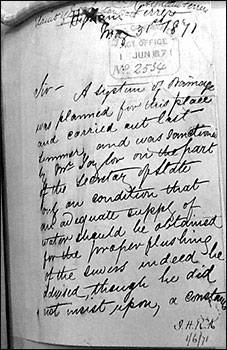 |
Letter
National Archives Kew, MH 13/241
|
|
The letter to Dr. Buchanan was passed to T. Taylor (Local Government Office, Medical Department, Whitehall) and he responded by writing to the Higham Ferrers Sewage Authority requesting further information, in particular seeking verification for the issues raised by Dr. Thompson in his original letter.
|
Referring to Mr Thompson's complaint of the sanitary state of Higham Ferrers, and to my letter to the school authority, dated 1st inst; on the same subject, I am directed by Mr Secretary Bruce to enquire whether the cases of enteric fever alluded to by Dr. Thompson have occurred in houses which can possibly have been affected fresh gases from the sewers or the house drains?
2. Are the foul contaminations from the sewers as general as Dr. Thompson describes them?
3. What are the means for flushing the sewers, and how often have these means been used during run last three months?
I am, Sir,
Your obedient servant
T Taylor8
|
|
The response from the Higham Ferrers Sewage Authority to T. Taylor did not convince Whitehall that the Authority had a strategy to resolve the issues. By September Whitehall decided that a thorough review of the situation was required and they commissioned Dr. Home to report on the conditions in Higham Ferrers.
|
To the Vestry Clerk
Sir,
I am directed by the Local Government Board to inform you that they have instructed their inspector, Dr. Home CB to enquire and report upon, the circumstances of the high rate of mortality from zymotic diseases in your parish.
Dr. Home will, upon his arrival in Higham Ferrers, place himself in communication with you, and I request that you render him all the assistance in your power.
I am sir,
Your obedient servant,
Edward Seaton9
|
|
Dr. Home’s visit to Higham Ferrers
Dr. Home visited Higham Ferrers in September and presented his report to Whitehall in November 1871.10 The conditions he described provided the evidence of why enteric fever was present in Higham Ferrers.
There were 263 houses of which ten were farmsteads. The houses of the “labouring poor” were “mostly old, inconveniently construct[ed] with imperfect ventilation.” They are described as “unfit for the decent residence of human beings.”
One third of the inhabitants used the water from the town well as the water in their own wells was bad, but “even the horses would not drink the water of the well after a fall of rain.” Of the sewage system “the Sewage Authority did not carry out any portion [of the work required] to obtain any important removal of excrement.” “It was evident that most of the wells in the town, by reason of their proximity to privies, cesspits, surface drains or washings from manure heaps, were likely to be contaminated”.
“At Bunkers Hill” (now Warmonds Hill) privies have been erected against the walls of some cottages, and the soil from them soaked into the rooms where the people live.” Privies were infrequently emptied and one at Kennel Row (broadly near Kings Meadow Lane now) which served four houses had “not been emptied for ten years – it was in the most horrible state; the broken door had been taken off and laid over the floor as a sort of grating, to keep people using the privy from contact with the liquid soil, which, oozing through the bricks, completely covered the floor”.
However, no cases of fever had occurred in Spring Gardens, a row of new houses. The probable reason for this being ”the ground around the houses has not yet become sodden with the impurities accruing from long inhabitation”.
Dr. Home concluded that the reasons for the outbreaks were the combination of ground sodden with leakage from privy pits and cesspools and drinking contaminate water from the wells.
His recommendations
He recommended three actions should be taken; these were the securing of wholesome water, improvement to the drains and ventilation of the sewers and the removal of excremental matter and house refuse. In this latter case he cites the “intolerable nuisance arising from the combination of slaughter-house, offal-boiling, and pig keeping at one place in the middle of the town should be abated”.
The death of Richard Alfred Hacon
However, between the time the report was commissioned and the time it was published Assistant Surgeon Richard Alfred Hacon had himself contracted enteric fever and died. He had been living as a lodger at No. 3 Hind Stile. Son of a General Practitioner in medicine in Aldborough, Norfolk, he had been practicing medicine in Higham Ferrers as an Assistant Surgeon. He was not listed in the UK Medical Register, unlike his father and eldest brother.
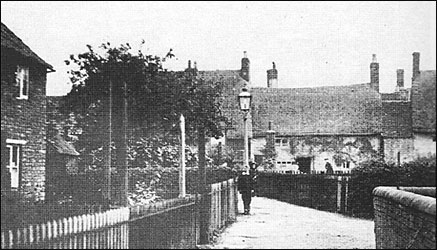 |
|
Town Yard looking towards Hind Stile (now Chichele Close)
showing the Hind Stile cottages.11
|
His death was greatly lamented by the people of Higham and surrounding villages. They respected Richard Hacon as someone who had worked assiduously on their behalf and the memorial erected to his memory records the “voluntary subscriptions of 1157 subscribers, chiefly of the working classes” who wished to acknowledge his “unremitting zeal in discharge of the laborious duties of his calling and of his unwearyingly self denial on their behalf.” He was 29 years old.
Higham Ferrers Sewerage Authorities response to Dr. Home’s report
Whitehall waited for a response from the Higham Ferrers Sewerage Authority to the issues raised by Dr. Home. They were very disappointed, and wrote to the Authority early in 1872 that their response was inadequate. By 1872 the number of deaths of children below the age of 10 dropped relative to the other age ranges, but the conditions linked to the outbreaks of enteric fever continued to be a major issue.
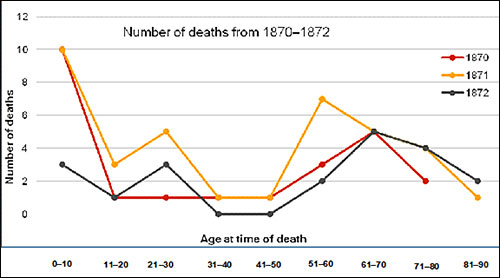 |
|
20 February 1872. Local Government Board. Medical Dept.13
Sir,
I am directed by the Local Government Board to acknowledge the receipt of your letter of the 6th inst, giving the results of the sanitary committee’s consideration of Dr. Home's report on enteric fever at Higham Ferrers.
The board request that the attention of the committee may be particularly directed to the following points referred to in Dr. Home's report, but in regard to which your letter does not contain any definite information.
The construction of the Privy pits and cesspools. Dr. Home’s reports that at Higham the Privy pits are, for the most part, unbricked; and that in some cases holes simply dug in the ground are used for the reception of slops, and occasionally receive excremental discharges. The pollution of the soil and water by these means is such as to be of a very serious consequence to health. Dr. Home also mentions particular instances of the ill construction of Privies at Bunkers Hill.
2. Dr. Home reports that the badly designed, and badly laid brick house drains, which were constructed before the present sewerage system still remain. Whether such drains have, or have not, in any case been constructed with new sewers (upon which point the notice enclosed in your letter does not appear to afford any information) such drains must frequently be productive of nuisances and injury to health.
3. In regard to the action which the Vestry shall decide to take in these matters, the Board request that further information be furnished to them.
4. With respect the three subjects to which your letter refers: – the water supply, the emptying of cesspools, and the ventilation of the sewers: – I am directed to make the following observations.
The Board have no doubt that, as stated by Dr. Home, many of the wells at Higham receive contaminated impurities. They therefore cannot consider the present water supply as a proper one; and they are of the opinion that until a supply of pure water is provided, epidemics of typhoid fever will, from time to time, occur among persons drinking water from these wells.
Accordingly, both to Dr. Home's report and to your letter, the emptying of the Privy pits, and the removal of house refuse, is not undertaken by the Vestry, or by any contractor under its superintendence, but is let to private enterprise. This plan, as appears from the Inspectors report, and as the experience of the Board would lead them to expect, is not successful in preventing accumulations dangerous to health, and the Board are of the opinion that the Vestry in not exercising the powers given to it in the 4th and 5th sections of the Sanitary Act. 1868, in reference to cesspools and cesspit, has seriously failed in its duty.
I am to request that the careful attention of the Vestry may be given to these matters, and that information on the course, which the Vestry intends to pursue in regard to each of them, and in regard to the ventilation of the sewers, may shortly be furnished to the Board.
I am Sir,
Your obedient servant
John Simon
|
|
Plan to use water from a moat – October 1871
The Higham Ferrers Sewerage Authority had proposed to resolve the issue of flushing the sewers using the water cart more effectively through drawing water from a small moat.
The plan14 put forward by Edward Sharman in October 1871 to use the small moat in Castle Fields.
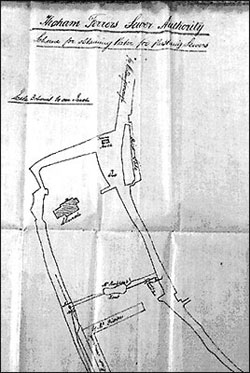 |
|
Plan
|
|
|
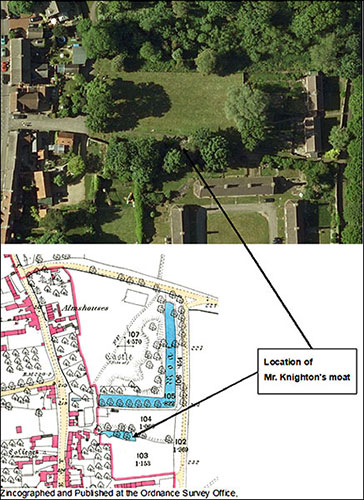 |
|
Reproduced with permission from the British Library
|
|
It shows the Church, and moat at the side of Castle Fields, extending
from Midland Road to College Street, labelled Mr Knighton’s Moat.
|
| To the bottom of the sketch ithe right-angled moat in Castle Fields. |
| Mr. Knighton’s moat was sited just above John White Close. Today it is no longer filled with water but with ivy, trees, and undergrowth. |
|
|
|
In October 1871 Mr. Sharman wrote to the Authority in support of his plan.15
|
I find Mr. Knighton's Moat to be about 3 feet deep on an average and I propose to lay a 3-inch iron pipe from same 12 inches below the present water level into a small brick pond to be constructed out of part of the Pound, from which the water cart can be filled by means of a pump. The water in the small brick pond will always stand at the same level as the water in Mr. Knighton's Moat. However, much water may be pumped out of the brick pond, about 2 feet of water will always be left in Mr. Knighton's Moat. It must be clearly understood that no water will pass through the proposed drain except when the land springs are running.
I have no data to guide me as to how many of the months of the year they are likely to run.
I estimate the cost of the works above described at about one hundred and two pounds and seven shillings £102.7.0. Edward Sharman. Architect Surveyor. Wellingborough
|
|
The proposed plan floundered as the owner of the moat did not wish to share his water supply with others lest it dry up and he would be forced to use the communal supply.
The removal of sewage problem was not resolved.
|
|
|
From October 1871 to May 1897
On the 3 March 187716 the Northampton Mercury reported a town meeting had discussed a report that Dr. Haviland (Medical Officer for Higham Ferrers) had written which stated “the sanitary condition of the town was in a very bad state [ ] the outlets of the sewers was complained of, and there were several closets connected with the sewers which ought not to be, as it was quite contrary to the River Pollutions Bill”. The meeting agreed that as the town had a great amount of typhoid fever the cause could be the water supply “as the water from the town pump was condemned some years since by Dr. Home of London” … “The Chairman wanted to know how often the sewers were flushed, and it was stated that there was no regular time” … The Chairman did not think the water was much at fault, as one doctor said it was very bad and another said it was very good; and when doctors disagree, who was to decide?”.
Dr. Havilland continued to report that the conditions regarding the sewer outfalls were unsatisfactory.17 In 1878 he wrote, “I visited the two sewer outfalls of [Higham Ferrers] alongside the common footpath and accommodation road known as King’s Lane. The sewage passes into an open drain through Mr. Randall’s field, and this contaminates the drinking water used by the cattle”. Describing the outfall on the Wellingborough Road (now Northampton Road) “I found it offensive and contaminated by sewerage. It is a nuisance detrimental to health”.
In March 189418 Dr. Crew (Medical Officer for Higham Ferrers) wrote to the Higham Ferrers Sewage Authority, “Many sanitary improvements have been carried out during the year. The conditions at Bunker’s Hill is much better than at the beginning of the year, and the general asphalting of the footways in the town, which were in a very bad state, not only adds much comfort to the public but is an excellent work from a sanitary point of view”.
|
Slow progress was being made, but not sufficiently quickly. In his report of 189619 Dr. Crew wrote:
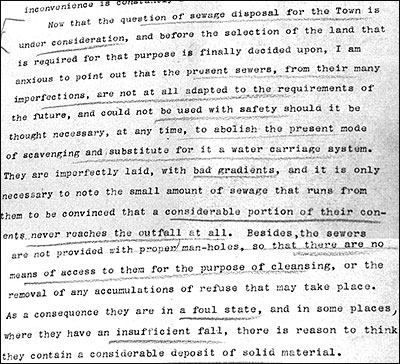 |
|
Dr Crew's Letter
|
Not all residents concurred with Dr. Crew that substantial progress had been made. Mr Hustwaite,20 in a letter oddly reminiscent of the original letter from Dr. Thompson a quarter of a century earlier wrote:
|
“Gentlemen, After over 7 years of water standing within a yard of my front door, 7 or 8 inches deep for months together in the winter after rain, And (sic) 11 more houses near me the same also a shocking stinking drain within 6 yards of my front door now I must appeal to you. Time after time I have appealed to the Council but nothing is done. The Mayor J Sanders a rich old gentleman owns 7/8 of the property sits on the Council they cannot make him move in the matter. My landlord lives in London. Everybody is complaining about it but nothing is done.
I remain yours respectfully
L Hustwaite.
The drain is on J Sanders The Mayor’s property.
|
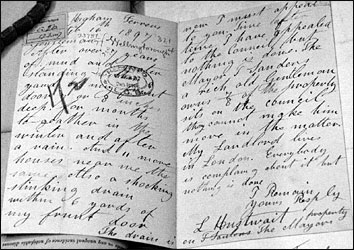 |
|
Mr Hustwaite's letter
|
|
|
The letter had its effect. The Town Clerk wrote back to Whitehall stating that repairs to the land in front of Mr. Hustwaite’s property would begin at once. However, they did not give in totally disputing that Mr. Hustwaite had appealed to them “time after time”. “In the opinion of the Town Council his statements are greatly exaggerated”.21 In refuting the counter claims by the Town Council Mr. Hustwaite ended his second letter to Whitehall:
“If England had no braver sons than those on the Town Council, God help us”.
The Higham Ferrers and Rushden Water Board
However, things were about to change.22
On Monday 3 May 1897 Higham Ferrers Town Council met to discuss a permanent water supply for the town. Mr. York the Borough Surveyor told the meeting he had written to Mr. Gataker, a water diviner, to let him know that a well had been sunk at the spot he indicated, but the water was insufficient.
In 1901 Rushden Council appointed Mr. Middleton, a water expert, to investigate the provision of pure water at Sharnbrook. He reported that trials indicated that this was an unlikely source.
In December 1901 a Town meeting in both Rushden and Higham received details of a proposed water venture and the resolution to adopt the scheme received overwhelming support. The Higham Ferrers and Rushden Water Board was established by Act of Parliament in 1902.
However, the progress of the enterprise was initially interrupted by court proceedings regarding the compulsory acquisition of land from several owners and then by the abnormal weather in November 1903. Just over 133 acres of land was eventually purchased in Sywell with a drainage area of 2000 acres. By April 1904 the work on the bank at Sywell had fallen well behind schedule and the contractor advertised for more men to augment the 110 already employed. The construction took three years in total to complete.
By January 1906 the reservoir contained 50 million gallons of water. The Sywell pumping station was built and tested, the test being the successful stream of pumped water being thrown over the church by the fire brigade. The formal opening of the reservoir took place on 2 July 2 1906. The project had cost the Water Board £110,000.
 |
Photograph by Mr. Samuel Powell of Rushden, shows the Union Jack flying on the new water tower, 1906.
|
|
The reservoir was very successful. First, it provided continuous clean water to the inhabitants of Higham Ferrers and Rushden. It held the equivalent of three years’ water supply for the two towns, a far cry from the efforts of taking a water cart around the houses. In January 1908 the Water Board Surveyor reported that over 5,000,000 gallons of water had been pumped from the reservoir. Second, it repaid the initial investment as water was sold to neighbouring villages. By 1928 water was being supplied to Wollaston, Wymington and Irchester.
By 1968 the Higham Ferrers and Rushden Water Board Annual Report stated that:
“The Board supplied a population of 35,500 covering an area of 45 square miles, with 103 miles of distribution main”.
The reservoir continued to supply water under the direction of the Higham Ferrers and Rushden Water Board, until 1974 when the Water Board was amalgamated into Anglian Water Authority. In 1979 Sywell reservoir was sold to Northamptonshire County Council for leisure pursuits.
It took from 1871 to 1906 for the sewage systems problems to be resolved, and many people played their part in its successful resolution, including Richard Alfred Hacon.
|
 |
Sywell Country Park in July 2016, showing the water tower and the embankment still in place, over 100 years after they were constructed.
|
|
| References |
| NRO |
Northampton Records Office |
|
1.
|
Minutes of a meeting held by Rev Alexander Dixon 19 December 1868. NRO |
|
2.
|
To Henry Greene, solicitor to the Higham Ferrers Sewerage Authority, from Tom Taylor, Whitehall 19 October 1869. NRO |
|
3.
|
Higham Ferrers Sewers Authority. 10 January 1870. Minutes (Mr Sharman was the Architect Surveyor based in Wellingborough, who designed |
|
4.
|
Graph from Infant Mortality: A Continuing Social Problem, ed: Garrett, Woods, Galley and Shelton, (Chapter 6) Infant Mortality in Nort |
|
5.
|
booty.org.uk/booty.weather/climate/1800_1849.htm. |
|
6.
|
Higham Ferrers Sewers Authority Minutes 23 March 1871. NRO |
|
7.
|
To Geo Buchanan Esq MD London from Dr. Thompson. May 1871. NRO |
|
8.
|
Whitehall. Local Government Office T Taylor 9 June 1871. NRO |
|
9.
|
Medical Department Local Government Board. 9 September 1871. NRO |
|
10.
|
Extracts from Dr. Home’s Report on Enteric Fever in Higham Ferrers (Northamptonshire) November 1871. Home, A.D. Report on Enteric Fever |
|
11.
|
Higham Ferrers: A Pictorial History, published by The Rotary Club of Rushden, 1984, p. 67. |
|
12.
|
Data from the death records for Higham Ferrers 1870–1872. NRO. Not all of the deaths were related the enteric fever. |
|
13.
|
To Henry Greene from John Simon, 20 February 1872. Local Government Board. Medical Dept. NRO |
|
14.
|
Sketch plan of proposed use of water from the moat to flush the sewers. Higham Ferrers Sewers Authority. Edward Sharman 1871. NRO |
|
15.
|
Letter from Edward Sharman to the Sewer Authority, October 1871. NRO |
|
16.
|
Northampton Mercury 03 March 1877 British Newspaper Archive. |
|
17.
|
Northampton Mercury 20 April 1878. British Newspaper Archive. |
|
18.
|
February 1894. Dr. Crew’s letter to the Higham Ferrers Sanitary Authority. National Archives Kew. MH 12/8920 1893–1896. |
|
19.
|
January 1897. Dr. Crew’s letter to the Higham Ferrers Sanitary Authority. National Archives Kew. MH 12/8920 1893–1896 |
|
20.
|
Letter from Mr Hustwaite 16 February 1897 National Archives Kew. MH 12/8926 1897–1900. |
|
21.
|
Letter to Whitehall from Higham Ferrers Town Council 2 March 1897. MH 12/8926 1897–1900. |
|
22.
|
This section makes extensive use of the material provided by Eric Fowell and Ann Cooper and the work that Rushden and District History |
|
|
|
|
|
|
|
|


